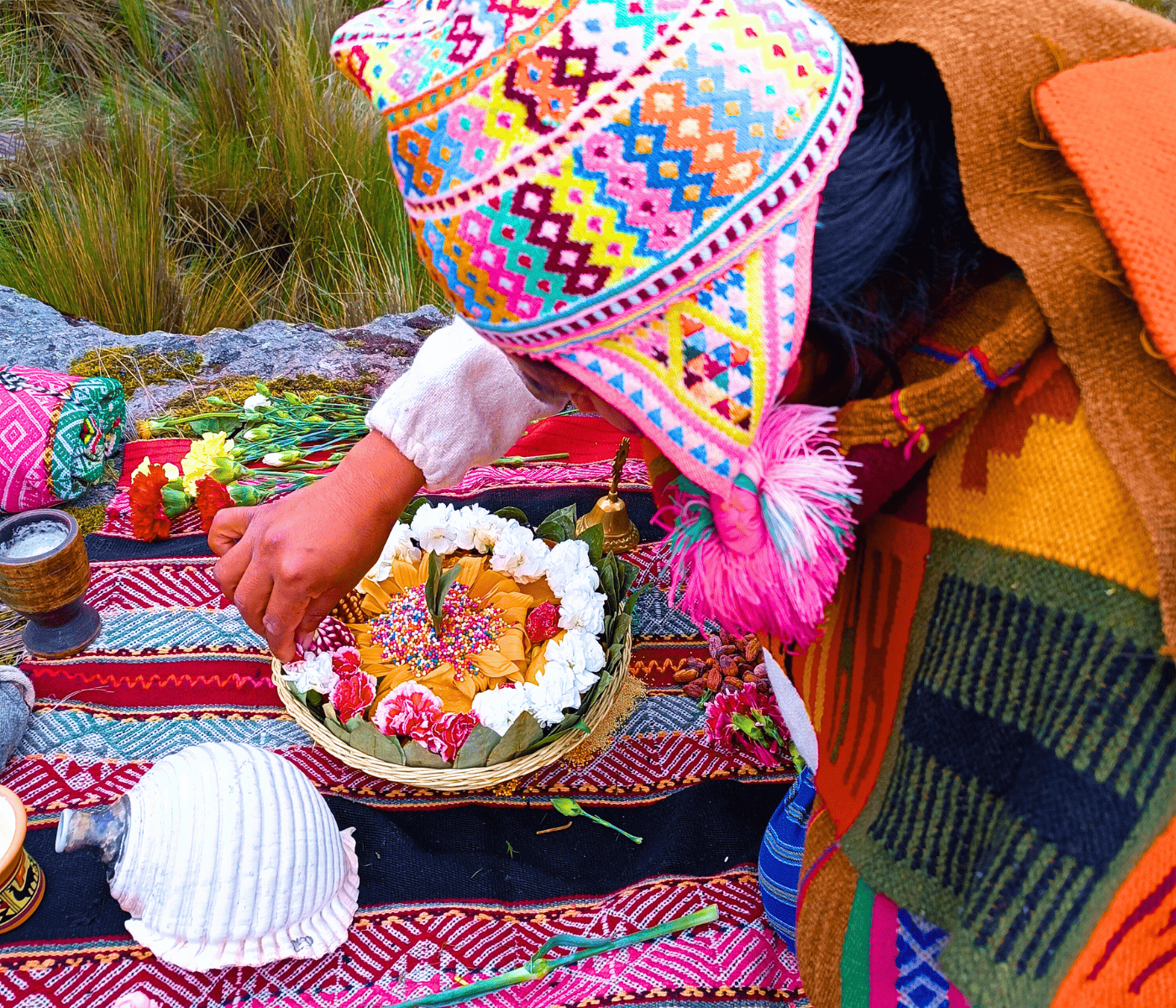The despacho is a deeply spiritual and important ritual in Andean traditions, involving the creation of a symbolic bundle with the intention of asking for blessings, protection, and balance. The ceremony is often performed to restore order, bring emotional and energetic healing, or seek guidance during times of crisis or transition.
The despacho ceremony includes prayers, songs (like icaros in shamanic traditions), and other methods of invoking the spirits of nature, such as Pachamama (Mother Earth) and the Apus (spirits of the mountains). The Andean worldview emphasizes the interconnectedness of all elements in nature—earth, mountains, and cosmos—making the despacho a spiritual act to honor and maintain these connections.
Central to the despacho is the principle of Ayni, the Andean belief in reciprocity, where offerings are made to Pachamama, the Apus, and other spiritual forces, ensuring a balanced exchange of energy. What is given to the Earth and the universe is always returned in a harmonious way. WillkapachaExperience organizes the despacho ceremony, guiding participants in its preparation and invocation. After the despacho is created, it may be buried, burned, or left in a sacred place (such as a mountain, river, or field) to return the energy to the universe, thereby restoring spiritual harmony and balance.
Why is the Despacho Ceremony Performed?
The Despacho Ceremony serves several purposes:
- Gratitude: To give thanks to the natural world for its blessings — such as abundance, life, and resources.
- Healing: To restore balance and harmony in one’s life or to ask for healing, either physically or spiritually.
- Prosperity: To ask for blessings of abundance, health, and good fortune in life.
- Protection: To seek guidance or protection from spiritual forces.
- Balance: To maintain harmony with the natural world and ensure that the cosmic forces remain in equilibrium.
- Transition: Calling for guidance and help during periods of change or crisis
Despacho – Offering of Gratitude
The offering of gratitude is a sacred act of thanks and reverence towards Mother Earth (Pachamama), the Apus (spirits of the mountains), and other spiritual forces. It is performed to express appreciation for the blessings, resources, and guidance received, while also seeking protection, prosperity, and balance for the future. This offering serves to honor the interconnectedness of all things and maintain harmony with the universe.
Gratitude offerings are often made during special occasions, such as harvests, spiritual ceremonies, or at the start of a new cycle. They can be conducted individually or collectively, and they play a crucial role in sustaining the flow of positive energy and ensuring continued well-being. Through this practice, participants reaffirm their respect for the natural and spiritual forces that sustain life, fostering a sense of reciprocity and harmony with the cosmos.
Preparing the Despacho
The Despacho is created with various symbolic elements, each representing a different aspect of life and the connection to the spiritual realms. These offerings often include:
- Coca Leaves: Sacred leaves used to communicate with higher spiritual realms.
- Grains, Seeds, and Corn: Representing fertility, abundance, and the sustenance provided by Pachamama.
- Flowers and Herbs: Symbolizing healing, vitality, and the life force of nature.
- Fruits and Sweets: Representing prosperity and the sweetness of life.
- Papers and Prayers: Where participants write their intentions, requests for protection, blessings, or guidance.
- Beverage, wine, wáter or any other natural beverage
The Offering and Its Final Steps
Once the Despacho is prepared, the next step is to offer it back to nature. The Despacho may be:
- Burned: Releasing the prayers and intentions into the spiritual realm through the smoke.
- Burying: Returning the offerings to Pachamama, honoring the cycle of life, death, and rebirth.
- Left in Sacred Places: Such as mountains, rivers, or fields, to complete the sacred exchange with the natural world.
By performing this act, participants give back what they have received, ensuring that balance is maintained in their lives and in the natural world.
Cultural Significance of the Despacho
In Andean culture, the despacho ceremony is not just about personal requests but also about maintaining harmony in the community and the environment. It is a social and collective activity, sometimes performed for the benefit of an entire group or community.
- Community Unity: The ceremony often brings people together, creating a sense of shared purpose and connection with the natural world and the spirits.
- Spiritual Alignment: It is a way of maintaining alignment with the natural cycles of the Earth, the seasons, and the cosmic forces. It is seen as a way to live in harmony with all living things.
Conclusion
The despacho is a profound spiritual practice that reflects the interconnectedness of all beings in the Andean worldview. It honors the relationship between humans and the natural world and helps restore harmony and balance. By preparing a despacho, participants are engaging in an ancient form of dialogue with the Earth and the cosmos, offering gratitude, seeking blessings, and maintaining the flow of positive energy through the principle of Ayni.
It’s a ceremony of respect, connection, and reciprocity that reaffirms the sacred relationship between people, nature, and the spiritual realms. WillkapachaExperience offers the opportunity to participate in this sacred tradition, guiding individuals through the despacho ceremony to connect with these powerful energies and restore balance in their lives.

